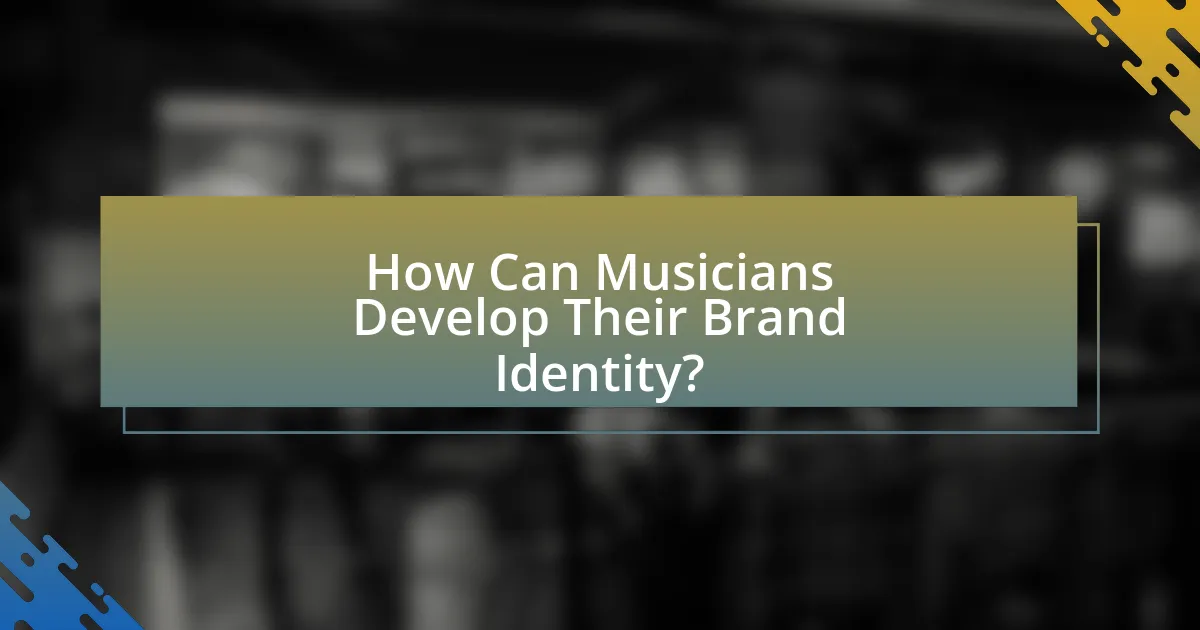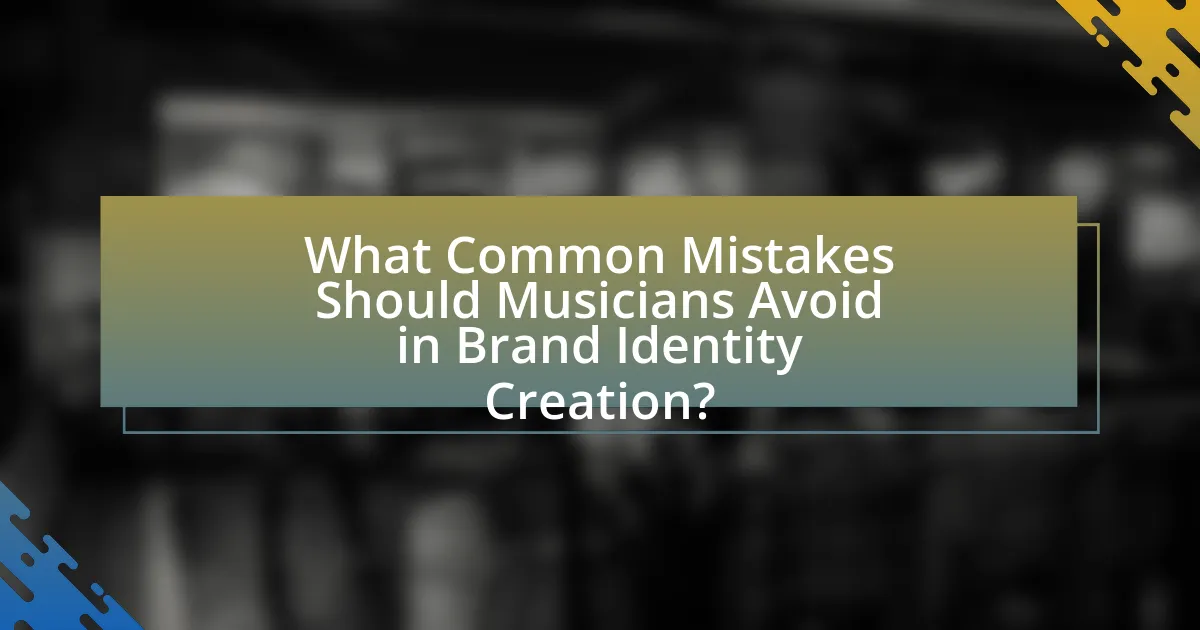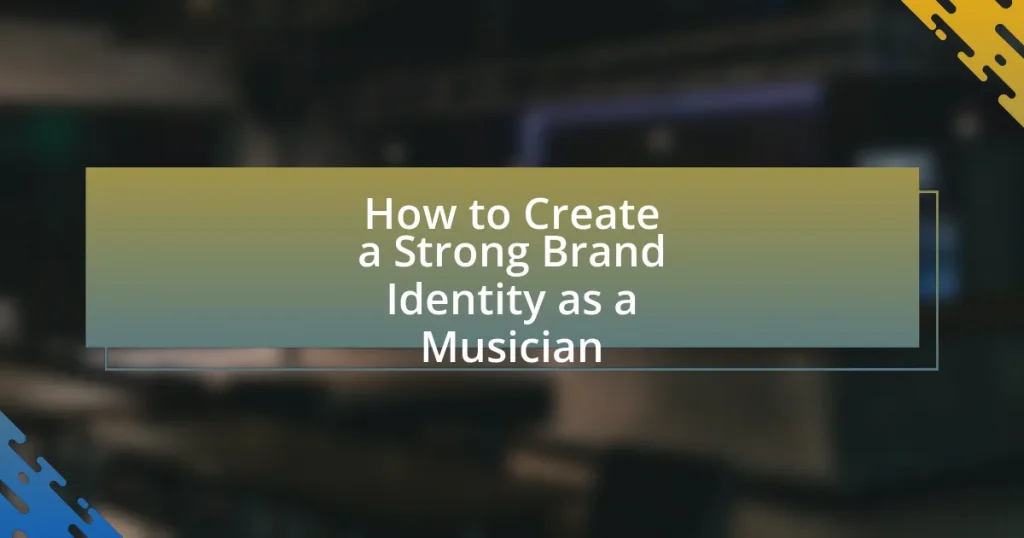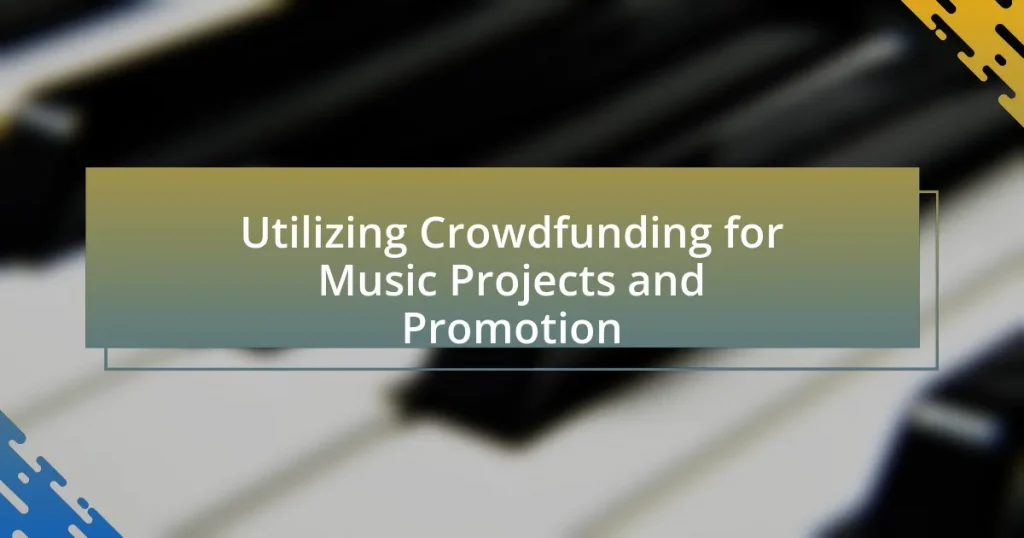A strong brand identity for a musician is essential for distinguishing themselves in a competitive market and fostering fan loyalty. This article outlines the key elements of a musician’s brand identity, including unique sound, visual aesthetics, messaging, and audience engagement strategies. It also explores how personal style influences brand perception, the importance of authenticity, and the role of storytelling in connecting with audiences. Additionally, the article provides practical steps for musicians to develop and maintain their brand identity, adapt over time, and avoid common pitfalls that can undermine their image and engagement with fans.

What is a Strong Brand Identity for a Musician?
A strong brand identity for a musician is a cohesive and recognizable image that reflects their unique style, values, and musical genre. This identity encompasses visual elements such as logos, color schemes, and album artwork, as well as auditory elements like signature sounds and lyrical themes. For instance, artists like Beyoncé and Taylor Swift have distinct brand identities that resonate with their audiences, contributing to their commercial success. Research indicates that musicians with a well-defined brand identity can increase fan loyalty and engagement, as evidenced by a study published in the Journal of Marketing Research, which found that brand consistency enhances consumer trust and recognition.
How does a musician’s brand identity differ from other industries?
A musician’s brand identity differs from other industries primarily due to its reliance on personal expression and emotional connection. Unlike traditional brands that often focus on product features or services, musicians create identities that reflect their unique artistic vision, lifestyle, and personal experiences. This is evident in how musicians use visual elements, such as album artwork and social media presence, to convey their persona, which is often intertwined with their music and public image. For instance, artists like Lady Gaga and Kanye West have cultivated distinct brand identities that emphasize individuality and provoke emotional responses, setting them apart from brands in sectors like retail or technology that prioritize functionality and consumer needs.
What are the key elements of a musician’s brand identity?
The key elements of a musician’s brand identity include their unique sound, visual aesthetics, messaging, and audience engagement. A unique sound differentiates the musician in a crowded market, while visual aesthetics, such as logos and album art, create a recognizable image. Messaging encompasses the values and stories conveyed through lyrics and public persona, establishing a connection with fans. Audience engagement strategies, including social media interaction and live performances, foster loyalty and community. These elements collectively shape how the musician is perceived and can significantly influence their success in the industry.
How does personal style influence a musician’s brand identity?
Personal style significantly influences a musician’s brand identity by shaping public perception and emotional connection with the audience. A musician’s unique fashion choices, visual aesthetics, and overall presentation create a recognizable image that distinguishes them from others in the industry. For instance, artists like Lady Gaga and David Bowie have utilized bold personal styles to establish strong, memorable identities that resonate with fans and enhance their marketability. This distinctiveness not only attracts attention but also fosters loyalty, as fans often feel a deeper connection to musicians who express individuality through their style.
Why is a strong brand identity important for musicians?
A strong brand identity is important for musicians because it differentiates them in a crowded market and fosters a loyal fan base. This differentiation allows musicians to convey their unique style, values, and message, making it easier for audiences to connect emotionally. Research indicates that 77% of consumers make purchases based on brand loyalty, highlighting the significance of a recognizable and relatable brand identity in driving sales and engagement. Furthermore, a well-defined brand identity can enhance marketing efforts, as consistent branding across platforms increases recognition by up to 80%, thereby amplifying a musician’s reach and impact.
How does brand identity impact a musician’s audience engagement?
Brand identity significantly impacts a musician’s audience engagement by shaping how fans perceive and connect with the artist. A strong brand identity, which includes visual elements, messaging, and overall persona, fosters emotional connections, making audiences more likely to engage through social media, attend concerts, and purchase merchandise. For instance, research by the University of Southern California found that musicians with a clear and consistent brand identity experience higher levels of fan loyalty and interaction, as fans feel a sense of belonging and alignment with the artist’s values and image. This connection enhances audience engagement, leading to increased support and participation in the musician’s career.
What role does brand identity play in a musician’s career longevity?
Brand identity significantly influences a musician’s career longevity by establishing a recognizable image and connection with their audience. A strong brand identity helps musicians differentiate themselves in a saturated market, fostering loyalty among fans and increasing opportunities for collaborations and endorsements. For instance, artists like Beyoncé and Taylor Swift have cultivated distinct brand identities that resonate with their audiences, contributing to their sustained success over decades. This connection not only enhances fan engagement but also leads to consistent revenue streams through merchandise, streaming, and live performances, ultimately supporting a longer career in the music industry.

How Can Musicians Develop Their Brand Identity?
Musicians can develop their brand identity by defining their unique sound, visual style, and message that resonates with their target audience. This involves creating consistent imagery, such as logos and album art, that reflects their musical genre and personal values. Additionally, engaging with fans through social media platforms and live performances helps to establish a recognizable presence. Research indicates that artists who maintain a cohesive brand across various channels are more likely to attract and retain a loyal fanbase, as seen in the success of musicians like Taylor Swift and Billie Eilish, who effectively communicate their brand through storytelling and visual aesthetics.
What steps should musicians take to create their brand identity?
Musicians should define their unique sound and style as the first step in creating their brand identity. This involves identifying the genre they resonate with and the elements that differentiate them from others. Next, musicians should develop a consistent visual identity, including logos, color schemes, and imagery that reflects their music and persona. Additionally, they must establish a strong online presence through social media platforms and a professional website to engage with their audience effectively. Finally, musicians should create a narrative or story that connects their music to their personal experiences, enhancing relatability and emotional connection with fans. These steps are essential for building a recognizable and authentic brand identity in the competitive music industry.
How can musicians define their target audience?
Musicians can define their target audience by analyzing demographic data, understanding listener preferences, and engaging with fans through social media and live events. By examining age, gender, location, and musical tastes, musicians can identify specific groups that resonate with their style. For instance, a study by Nielsen Music found that 67% of music listeners are influenced by genre-specific marketing, indicating the importance of tailoring content to audience preferences. Additionally, utilizing platforms like Instagram and Facebook allows musicians to gather insights on follower engagement, helping to refine their audience profile further.
What tools can musicians use to express their brand visually?
Musicians can use graphic design software, social media platforms, and merchandise to express their brand visually. Graphic design software like Adobe Photoshop and Canva allows musicians to create album covers, promotional materials, and social media graphics that reflect their artistic identity. Social media platforms such as Instagram and TikTok enable musicians to share visual content, engage with fans, and showcase their brand aesthetics through photos and videos. Additionally, merchandise like clothing and accessories featuring unique designs can serve as a tangible representation of a musician’s brand, helping to establish a recognizable visual identity.
How can musicians effectively communicate their brand identity?
Musicians can effectively communicate their brand identity by consistently aligning their music, visuals, and messaging across all platforms. This alignment ensures that fans and potential listeners can easily recognize and connect with the musician’s unique style and values. For instance, a study by the University of Southern California found that artists who maintain a cohesive brand presence on social media platforms experience a 30% increase in audience engagement. By utilizing distinct imagery, a signature sound, and authentic storytelling, musicians can create a memorable brand that resonates with their target audience.
What platforms are best for showcasing a musician’s brand?
The best platforms for showcasing a musician’s brand are Instagram, YouTube, Spotify, and TikTok. Instagram allows musicians to share visual content and engage with fans through stories and posts, making it ideal for brand building. YouTube serves as a powerful platform for music videos and behind-the-scenes content, reaching a wide audience and enhancing visibility. Spotify is essential for music distribution and playlist placements, which can significantly increase a musician’s reach and brand recognition. TikTok has rapidly become a key platform for viral music promotion, enabling musicians to connect with younger audiences through short, engaging videos. These platforms collectively provide diverse avenues for musicians to effectively showcase their brand and connect with their audience.
How can storytelling enhance a musician’s brand identity?
Storytelling enhances a musician’s brand identity by creating an emotional connection with the audience. This connection fosters loyalty and engagement, as fans relate to the musician’s personal experiences and narratives. For instance, musicians like Taylor Swift have successfully used storytelling in their lyrics and public personas to convey their life journeys, which resonates deeply with their audience, leading to a strong and recognizable brand identity. Research indicates that brands that effectively use storytelling can increase customer engagement by up to 300%, demonstrating the power of narrative in building a musician’s brand.

What Common Mistakes Should Musicians Avoid in Brand Identity Creation?
Musicians should avoid inconsistency in their brand identity creation. Inconsistent messaging, visuals, and audience engagement can confuse fans and dilute the brand’s impact. For instance, a study by the Branding Institute found that brands with consistent presentation across all platforms can increase revenue by up to 23%. Additionally, musicians often overlook the importance of understanding their target audience, which can lead to misaligned branding efforts. A clear understanding of the audience’s preferences and values is crucial for effective brand identity.
What are the pitfalls of inconsistent branding for musicians?
Inconsistent branding for musicians can lead to confusion among fans and a diluted image. When a musician’s visual elements, messaging, and overall style vary significantly across platforms, it undermines their identity and makes it difficult for audiences to connect. This inconsistency can result in decreased fan loyalty, as listeners may struggle to identify with an artist who lacks a clear and cohesive brand. Additionally, research indicates that brands with consistent presentation can increase revenue by up to 23%, highlighting the financial implications of branding inconsistency. Therefore, musicians risk losing both audience engagement and potential income when their branding lacks uniformity.
How can musicians ensure their branding remains authentic?
Musicians can ensure their branding remains authentic by staying true to their personal values and artistic vision. This involves clearly defining their unique sound, style, and message, which should resonate with their genuine experiences and beliefs. For instance, artists like Taylor Swift have successfully maintained authenticity by writing songs that reflect their personal life stories and emotions, creating a strong connection with their audience. Additionally, engaging directly with fans through social media and live performances allows musicians to foster a transparent relationship, reinforcing their brand’s authenticity.
What are the consequences of neglecting audience feedback?
Neglecting audience feedback can lead to a disconnect between the musician and their fanbase, resulting in decreased engagement and loyalty. When musicians ignore feedback, they risk alienating their audience, which can manifest in reduced attendance at performances and lower sales of music and merchandise. According to a study by the International Journal of Arts Management, artists who actively engage with their audience’s feedback see a 30% increase in fan retention compared to those who do not. This highlights the importance of audience feedback in maintaining a strong brand identity and fostering a loyal community around the musician’s work.
How can musicians adapt their brand identity over time?
Musicians can adapt their brand identity over time by evolving their image, sound, and engagement strategies to reflect changes in their artistic vision and audience preferences. This evolution can involve experimenting with new musical styles, collaborating with diverse artists, and utilizing social media platforms to connect with fans in innovative ways. For instance, artists like Taylor Swift have successfully transitioned from country to pop, demonstrating adaptability while maintaining a core brand identity. Additionally, data from a 2021 Nielsen report indicates that 70% of music consumers prefer artists who are authentic and relatable, emphasizing the importance of aligning brand identity with audience expectations.
What signs indicate that a musician should rebrand?
A musician should consider rebranding when they experience a significant shift in their musical style or target audience. This change can manifest through a decline in engagement or relevance within their current genre, indicating that their existing brand no longer resonates with listeners. Additionally, if a musician receives consistent feedback suggesting a disconnect between their image and music, it may signal the need for a rebrand. For instance, artists like Taylor Swift successfully rebranded from country to pop, reflecting their evolving artistry and audience. Such strategic shifts can rejuvenate a musician’s career and align their brand with their current artistic vision.
How can musicians evolve their brand without losing their core identity?
Musicians can evolve their brand without losing their core identity by integrating new influences while remaining true to their original sound and values. This approach allows artists to explore different genres or styles, which can attract a broader audience, while still reflecting the essence of their music and message. For instance, artists like Taylor Swift successfully transitioned from country to pop by maintaining her songwriting authenticity and personal storytelling, which are central to her identity. This strategy demonstrates that musicians can innovate and adapt while preserving the foundational elements that define them.
What are some best practices for maintaining a strong brand identity?
To maintain a strong brand identity, musicians should consistently communicate their unique style and values across all platforms. This involves using a cohesive visual aesthetic, such as logos, color schemes, and imagery that reflect their music genre and personal story. For instance, artists like Billie Eilish utilize distinct visuals and themes that resonate with their audience, reinforcing their brand identity. Additionally, engaging with fans through social media and live performances helps to build a loyal community, further solidifying the brand. Regularly updating content while staying true to core values ensures that the brand remains relevant and recognizable in a competitive industry.
How can musicians regularly assess their brand identity’s effectiveness?
Musicians can regularly assess their brand identity’s effectiveness by analyzing audience engagement metrics, such as social media interactions, streaming statistics, and concert attendance. These metrics provide quantitative data that reflects how well the brand resonates with listeners. For instance, a study by Nielsen Music found that artists with higher social media engagement tend to have increased streaming numbers, indicating a strong brand connection. Additionally, conducting surveys or focus groups can yield qualitative insights into audience perceptions, helping musicians understand their brand’s impact and areas for improvement.
What strategies can musicians use to stay relevant in the industry?
Musicians can stay relevant in the industry by actively engaging with their audience through social media, consistently releasing new content, and collaborating with other artists. Engaging with fans on platforms like Instagram and TikTok allows musicians to build a loyal following and receive immediate feedback. Consistent content release, such as singles or music videos, keeps the audience interested and maintains visibility in a crowded market. Collaborations with other artists can introduce musicians to new fan bases and create fresh sounds, enhancing their appeal. According to a 2021 report by the International Federation of the Phonographic Industry, artists who leverage social media effectively see a 30% increase in fan engagement, demonstrating the importance of these strategies in maintaining relevance.















